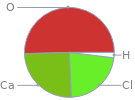Input interpretation

calcium perchlorate tetrahydrate | elemental composition
Result

Find the elemental composition for calcium perchlorate tetrahydrate in terms of the atom and mass percents: atom percent = N_i/N_atoms × 100% mass percent = (N_im_i)/m × 100% Plan: • Write the chemical formula and gather atomic masses from the periodic table. • Determine values for N_i, m_i, N_atoms and m using these items. • Finally, compute the percents and check the results. Write the chemical formula: Ca(ClO_4)_2·4H_2O Use the chemical formula, Ca(ClO_4)_2·4H_2O, to count the number of atoms, N_i, for each element and find the total number of atoms, N_atoms: | number of atoms Ca (calcium) | 1 Cl (chlorine) | 1 H (hydrogen) | 3 O (oxygen) | 5 N_atoms = 1 + 1 + 3 + 5 = 10 Divide each N_i by N_atoms to calculate atom fractions. Then use the property that atom fractions must sum to one to check the work: | number of atoms | atom fraction Ca (calcium) | 1 | 1/10 Cl (chlorine) | 1 | 1/10 H (hydrogen) | 3 | 3/10 O (oxygen) | 5 | 5/10 Check: 1/10 + 1/10 + 3/10 + 5/10 = 1 Compute atom percents using the atom fractions: | number of atoms | atom percent Ca (calcium) | 1 | 1/10 × 100% = 10.00% Cl (chlorine) | 1 | 1/10 × 100% = 10.00% H (hydrogen) | 3 | 3/10 × 100% = 30.0% O (oxygen) | 5 | 5/10 × 100% = 50.0% Look up the atomic mass, m_i, in unified atomic mass units, u, for each element in the periodic table: | number of atoms | atom percent | atomic mass/u Ca (calcium) | 1 | 10.00% | 40.078 Cl (chlorine) | 1 | 10.00% | 35.45 H (hydrogen) | 3 | 30.0% | 1.008 O (oxygen) | 5 | 50.0% | 15.999 Multiply N_i by m_i to compute the mass for each element. Then sum those values to compute the molecular mass, m: | number of atoms | atom percent | atomic mass/u | mass/u Ca (calcium) | 1 | 10.00% | 40.078 | 1 × 40.078 = 40.078 Cl (chlorine) | 1 | 10.00% | 35.45 | 1 × 35.45 = 35.45 H (hydrogen) | 3 | 30.0% | 1.008 | 3 × 1.008 = 3.024 O (oxygen) | 5 | 50.0% | 15.999 | 5 × 15.999 = 79.995 m = 40.078 u + 35.45 u + 3.024 u + 79.995 u = 158.547 u Divide the mass for each element by m to calculate mass fractions. Then use the property that mass fractions must sum to one to check the work: | number of atoms | atom percent | mass fraction Ca (calcium) | 1 | 10.00% | 40.078/158.547 Cl (chlorine) | 1 | 10.00% | 35.45/158.547 H (hydrogen) | 3 | 30.0% | 3.024/158.547 O (oxygen) | 5 | 50.0% | 79.995/158.547 Check: 40.078/158.547 + 35.45/158.547 + 3.024/158.547 + 79.995/158.547 = 1 Compute mass percents using the mass fractions: Answer: | | | number of atoms | atom percent | mass percent Ca (calcium) | 1 | 10.00% | 40.078/158.547 × 100% = 25.28% Cl (chlorine) | 1 | 10.00% | 35.45/158.547 × 100% = 22.36% H (hydrogen) | 3 | 30.0% | 3.024/158.547 × 100% = 1.907% O (oxygen) | 5 | 50.0% | 79.995/158.547 × 100% = 50.46%
Mass fraction pie chart

Mass fraction pie chart